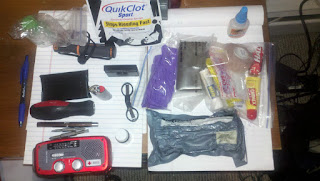In my last post I reviewed the pack I use as part of my everyday carry. Today I'm going to talk about the items I carry inside of it.
Starting in the upper left hand corner on the picture below I have hand sanitizer (also a nice addition to starting a camp fire), Quik Clot Gauze, a Gerber Bear Grylls fire-starter and whistle, about ten feet of duct tape wrapped around a credit card, a screw driver with two flat head and two Phillips bits, a Bic lighter, a Gerber knife sharpener, a pair of travel scissors, water treatment tablets, four nitrile gloves - a pair for me and someone else, a muslin bandage, ten small bandages, a half dozen powdered drink mixes, more ibuprofen, self-adhesive tape, two handi-wipes, lip balm, cough drops, an ink pen, a large rubber band and super glue.
I carry an Israeli Battle Dressing in my pack as well. It does not fit in the case with the other items. It is vacuum sealed and self-contained. Is it perfect? Definitely not, but it does give me peace of mind while I'm strolling about.

Starting in the upper left hand corner on the picture below I have hand sanitizer (also a nice addition to starting a camp fire), Quik Clot Gauze, a Gerber Bear Grylls fire-starter and whistle, about ten feet of duct tape wrapped around a credit card, a screw driver with two flat head and two Phillips bits, a Bic lighter, a Gerber knife sharpener, a pair of travel scissors, water treatment tablets, four nitrile gloves - a pair for me and someone else, a muslin bandage, ten small bandages, a half dozen powdered drink mixes, more ibuprofen, self-adhesive tape, two handi-wipes, lip balm, cough drops, an ink pen, a large rubber band and super glue.
I carry an Israeli Battle Dressing in my pack as well. It does not fit in the case with the other items. It is vacuum sealed and self-contained. Is it perfect? Definitely not, but it does give me peace of mind while I'm strolling about.

Name Your Link



